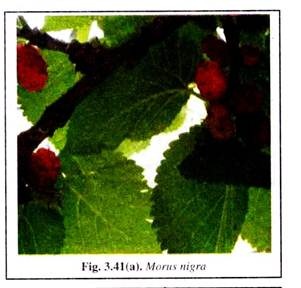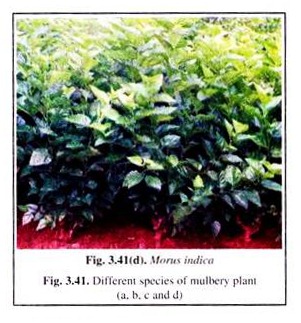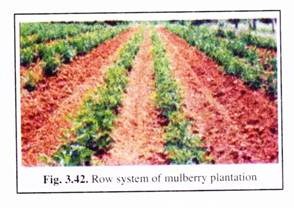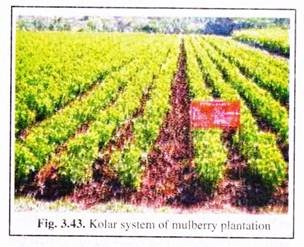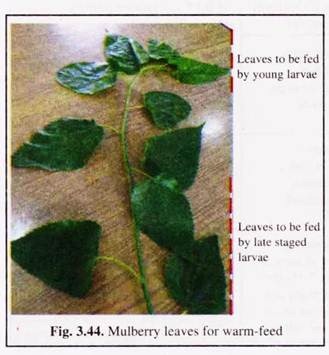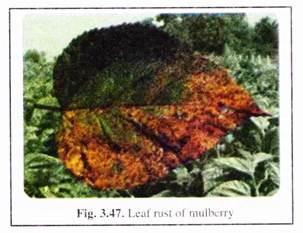Read this article to learn about common Indian Mulberry Plants and their Morphological Characteristics!
Introduction to Mulberry Plant:
Bombyx mori is a monophagous insect, feeding only mulberry leaves. Mulberry is a perennial plant belonging to the family Moraceae and includes a number of species and varieties. The nutritive value and palatability of different varieties are variable.
The returns from sericulture, mainly the quality of cocoons, depend primarily on the nutritive quality of the mulberry leaves given to the larvae during rearing. In different countries, having sericulture practice, attempts were made to find out suitable substitute for mulberry as the sole important diet of silkworms. In the first approach, feeding of larvae with leaves of some other plants was tried.
Their larval life was prolonged, cocoons spun were smaller and metamorphosis often failed. Therefore, other plants could not replace mulberry for commercial silkworm rearing.
In another attempt, polyphagous races of silkmoth have been raised, e.g., Asagiri (1990), Shin (1992) in Japan, but these were not suitable in Indian environment. In Japan, synthetic or semisynthetic diet using no or little mulberry leaves was formulated and was found to be very useful.
ADVERTISEMENTS:
However, in India artificial diet was not successful. Therefore, in Indian context, successful sericulture solely depends upon mulberry cultivation.
Meaning of Moriculture:
The effortful cultivation of mulberry plants for harvesting the leaves that to be used as food for the silkworms in sericulture is referred to as moriculture. In every successful sericulture practice, moriculture is run along with other processes of sericulture and about two-third of the cost of production incurred is spent on moriculture.
Common Indian Mulberry Plants and their Morphological Characteristics:
In India, several species of mulberry plants are available. But for sericultural practice, excessive hybridisation was done between recognised, useful species, to evolve new varieties with characters favourable for sericulture.
Most common Indian Mulberry Species include:
ADVERTISEMENTS:
(i) Morus nigra (Fig. 3.41a), M. alba (Fig. 3.41b), M. latifolia (Fig. 3.41c), M. indica (Fig. 3.41 d) and M laevigata.
Geographical Distribution:
Mulberry is a native plant of lower ranges of the Himalayas either of India or China. In China, the earliest record of mulberry cultivation was noted in 2800 B. C. The other important mulberry growing countries are Japan, India, former USSR, Myanmar, Bangladesh, Vietnam, Egypt, Greece, France, Hungary, Indonesia, Lebanon, Korea and Syria, etc.
In India, it is cultivated in West Bengal, Karnataka, Tamil Nadu. Himachal Pradesh, Jammu and Kashmir, Uttar Pradesh and Assam, etc.
Factors Required for Mulberry Cultivation:
Mulberry can grow in a wide range of environment.
However, the optimum physical conditions required for its growth are as follows:
(1) Temperature:
The temperature range required for mulberry growth is 24°-29°C. The plant cannot sprout below 13°C or above 38°C. So cultivation should not be done beyond that range.
(2) Rainfall:
ADVERTISEMENTS:
Rainfall ranging from 600-2,500 mm per year is ideal for mulberry growth. However, low yield and growth under low rainfall can be improved by supplemental irrigation.
(3) Humidity:
The ideal atmospheric humidity for mulberry growth varies from 65 to 80%.
(4) Daylight:
In temperate regions 5 to 10 hours of daylight and in tropical zone 9 to 13 hours of daylight are sufficient for normal growth of mulberry plant.
(5) Elevation:
In nature, mulberry can grow in higher altitudes. But for cultivation purpose, an elevation of 300 to 900 m above the sea level is favourable. Above that elevation, harvesting and other cultural practices will be difficult.
(6) Soil:
Being deep-rooted plant, soil should be deep, fertile, porous, well-drained with good water- holding capacity. Thus, loamy, clayey-loamy or sandy-loamy soils are best suitable for mulberry plantation. The expected pH of soil should be 6.2 to 6.8.
(7) Other Desirable Factors:
Location of mulberry field should be near to silkworm rearing place. It should not be close to any chemical factories, tobacco fields, chilli fields and industrial belts.
Recommended Varieties of Mulberry for Moriculture:
In different states of India like West Bengal, Karnataka, Tamil Nadu, etc., varieties of Morus indica are found to grow. However, because of their poor yield, many improved high yielding varieties have been evolved through hybridisation between local and exotic varieties by scientists of different Central and State Sericulture Research Institutes.
The varieties that can be cultivated throughout India include Mysore Local, Kanva-2, MR-2, Jatinuni, Maulainuni, C-763, S-799, etc.
After a great trial, scientists of CSB and different State Boards have suggested some varieties specific for different conditions which are as follows:
(1) According to Soil Type:
For alluvial soil of Gangetic plains, S-1, S-1635 and S-799 are suitable. On the other hand, C-776, S-1 for saline or alkaline soil; C-776 and C-763 have been recommended for laterite soil.
(2) According to Water Availability:
In heavy rainfall regions of Assam and West Bengal, most suitable varieties are S-1, C-763 and S-795. Drought tolerant varieties include C-776, C-763, S-13, S-14, etc.
(3) According to Plantation:
For tree plantation, recommended varieties are S-1301, S-36, S-523, TR-8, M. laevigata, Ber-S-1, etc. Kanra 2, and local are ideal for bush type, while there is no specific variety for middling plantation.
Recommended Practice Schedule of Moriculture:
In India, since ancient period, mulberry has been cultivated for its multipurpose uses than for sericulture. After the establishment of Central Silk Board, emphasis has been put on mulberry culture or moriculture along with sericulture.
Research workers from Central Silk Research and Training Institute, Mysore and Berhampore have carried out intensive work on different aspects of moriculture in order to improve mulberry yield per unit area at reduced cost.
They provided some guidelines for economic mulberry cultivation and distributed that to commercial rearers through state governments and their extension centres. However, rearer adopted some modifications, suitable for specific varieties, ecoclimatic conditions and silkmoth species of their choice. Here the basic guidelines for ideal moriculture will be discussed in brief.
Land Preparation for Mulberry Cultivation:
Before starting moriculture, the land taken for mulberry cultivation will be prepared properly. After removal of gravels and weeds, the land is levelled and then ploughed up to a depth of 12″ to 15″. Organic manures like compost or cattle yard manure is added with the soil by repeated ploughing. Recommended dose of manure is 10 tonnes per hectare for rainfed land or 20 tonnes per hectare for irrigated land.
Season and Direction of Plantation:
In Tamil Nadu and Karnataka, ideal plantation time is July-August when south-west monsoon begins. In West Bengal, the recommended time is November when north-east monsoon is over. No plantation should be made during summer or winter and rainy season which may result in rotting of cuttings or seedlings.
In tropical places, plantation can be done in any direction due to plenty sunlight. In temperate regions, plantation should be made in a direction facing sunlight and parallel to wind direction.
Plantation System:
(1) Pit System:
This system is adopted for rain- fed crop. Here, instead of ploughing the entire field, pits (40 x 40 x 40 cm) are dug with an inter row and inter pit space of 90 x 90 cm for bush type of plantation. In case of high bush type, the distance should be 180 x 90 cm and 270 x 270 cm for tree plantation.
Where the pit size will also be larger like 45 x 45 x 45 cm. After planting the cutting or sample, each pit will be filled with a mixture of organic manure, red soil and sand. Till root develops, they should be watered daily.
(2) Row System:
This system is followed in case of irrigated cultivation, e.g., in South India. In the land, following thorough ploughing, ridges and furrows are made keeping a distance of 45-60 cm between two ridges (Fig. 3.42). Then from one end of a ridge to the opposite end, a rope with knots at equal distance of about 45-60 cm is tied.
On either side of that ridge, cuttings are then planted at the point of each knot. Irrigated water flows through the furrows between the rows and feed the plants.
(3) Kolar System:
It is a modified row system that found in Kolar district of Karnataka. Here the distance between the rows is kept 30-45 cm and that between two plants is about 10-15 cm (Fig. 3.43).
(4) Strip System:
It is adopted in West Bengal. This is a very close system of cultivation where mulberry is grown in strips. Each strip has either two (Dothaki) or three (Thethaki) rows. In such strips, cuttings/samples are planted at a distance of 15 cm between the rows and also between two plants, within a row. Each strip is separated from the adjacent strip by a wide distance.
(5) Angular System:
For better soil and moisture conservation, increased leaf production and economic water management, a new system of mulberry cultivation was developed for the slopes for Nilgiri. In this system, the cuttings are planted in the rows in such a way that they form a triangular arrangement. It allows more plants in a given space.
Propagation of Mulberry Plants:
Seedling Propagation:
Because of a wind pollinated plant, purity of mulberry cannot be maintained by seedling propagation in commercial practices. Moreover, it takes long time to reach the leaf at harvestable stage if propagated by seedlings. However, in research centres, through manipulation of pollination process, this propagation is carried out to produce desired varieties of mulberry plants.
Freshly collected viable seeds are sown in well ploughed seed bed at a depth of less than 25 mm. The seed beds are watered through a can and kept protected from sunlight by covering with coconut leaves or mats of bamboo strips. Seeds germinate in 10 days.
After three months the seedlings are first transplanted to give a wider space of 23 cm between them. They can be transplanted once again to their final field after two years. Thereafter, these plants can be used for making cuttings or grafting.
Vegetative Propagation:
In all commercial sericulture practices, vegetative propagation of mulberry plant is adopted by following methods:
(a) Cutting:
Pencil thick branches from 8-10 months old plants of desired variety are cut into 7″-8″ long pieces. For irrigated plantation, each cutting should have minimum 3 internodes with well- developed buds and for rain-fed plantation; there will be 5-6 internodes in one cutting.
These cuttings are then planted in already prepared nursery, keeping about 2.5 cm with one node above the soil. Following 10 days of watering, roots develop in the internode under the soil and leaves from the aerial bud.
For quicker or easy root development, various growth regulators or hormones like indole acetic acid (IAA), indole butyric acid (IBA), L naphthaline acetic acid (NAA), etc. can be applied to the lower cut end of cuttings prior to plantation. Healthy cuttings are supplied by Central and State Sericulture Departments to the farmer at nominal cost. Cutting method of propagation is followed in South India.
(b) Grafting:
In grafting, the scion is selected from desired variety of mulberry while the stock is taken from hardy, local variety. Cut end of scion is placed on the cut end of stock in such a way that they unite and grow as one plant. Grafting may be root grafting, shoot grafting or bud grafting depending upon the scion material used. But in all cases scion and stock should be compatible.
(c) Layering:
Layering involves development of roots from a stem (mature) while it is still attached to the mother plant. Rooted stem is called layer. To make the layer, the branch is bent so that it contacts the soil and then gets covered with soil.
After roots develop, the branch is cut from mother plant and planted again. In trench layering as adopted in Japan, considerable length of the middle part with few nodded buds is covered under soil. New shoots and roots develop from each bud. Thus, a number of plants can be grown from a single branch.
(d) Gooting/Air layering:
In this method of vegetative propagation, 12 cm circular bark is removed from the middle part of a healthy branch. Peat mass or decomposed organic manure with little root hormone is then placed around that region and tied with polythene covering. Water should be sprinkled in that region till the roots develop in the next 1-2 months. Then the rooted branch is cut from the parent and planted elsewhere.
(3) Micro-Propagation:
Traditional methods of propagation like all vegetative processes including seedling propagation need locally adapted varieties of mulberry plant. So these methods require long time to establish. Grafting though allowed generation of new varieties, take much labour, time, and yield is also less.
Therefore, with the development of current research in plant biotechnology, several techniques have evolved to propagate in short time and generate new varieties of any plant with desired characters. These techniques have been tried for mulberry plant as well.
Some of such in vitro techniques are as follows:
(a) Tissue Culture:
Meristems from axillary or apical buds are taken from desired variety of mulberry plant. These are then grown to form callus in defined nutrient medium. From the callus derived from a single bud, 8-9 new plants can be grown by 3 months.
(b) Endosperm Culture:
Tissues of triploid (3n) endosperm is collected from triploid variety of mulberry plant and grown to form callus in tissue culture medium. Plants generated from the callus triploid are high yielder and rich in nutrients.
(c) Synthetic Seeds:
In this method, somatic embryos/axillary buds or meristem are encapsulated in a gel, that mimics the seed coat. These artificial seeds can be germinated in vitro in nutrient medium or in the soil directly. Propagation by artificial seeds save time and labour spent for pruning, cutting, transportation, etc.
(d) Somoclonal variation:
Somoclonal variation can be induced externally with mutagens. Callus with desired character can be generated from such somoclonal variated tissues. SV1 is one of mulberry variety that developed from callus with somoclonal variation.
(e) Somatic Hybridisation:
Somatic hybridisation can be done through fusion between protoplasts taken from two varieties having desired characters (e.g., high yield, hardy nature, disease resistant). Hybrid plants produced by this protoplast culture are of better quality than produced by routine grafting.
(f) Genetic Engineering:
Genes of desired characters can be isolated and cloned. The cloned gene then can be introduced into the plants by direct methods (e.g., electroporation, microinjection, micro- projectile bombardment) or by indirect method (e.g., by plasmid or other vectors).
All such laboratory-based techniques for propagation are now being practised in different research centres of India and the resultant products are then handed over to the farmers.
Irrigation of Mulberry Plant:
The survivality of mulberry plant does not depend on soil water content but the quantity as well as quality of leaves harvested from the plants absolutely depends on availability of soil water.
Irrigation almost doubles the yield and improves the protein and moisture content of leaves than those from rain-fed crops. So mulberry cultivation needs irrigation at least once in 8-10 days for sandy soil to once in 15 days for clayey soil.
The mulberry field may be irrigated by various methods like furrow method, basin method, flat bed method, overhead sprinkler method, micro-irrigation method, etc.
However, in all cases, appropriate drainage system must be in the field to remove the excess water.
This is essential:
(i) To prevent root rotten by water logging,
(ii) To increase the microfauna population of the soil and
(iii) For leaching of excess salts.
Manuring of Mulberry Plant:
Mulberry is a fast growing plant and thus consumes the soil nutrients quickly. Regular manuring the mulberry field is required for the normal growth and maximum leaf-yield from the plants. Manures may be applied as organic or synthetic chemical forms or as bio-fertilisers.
Most frequently used organic manures include compost, sericulture wastes, poultry manure, green manure, oil cakes, biogas slurry, farm yard manure, etc. Organic manures increase the nutrient content of the soil, conserve soil moisture and enhance biological activities of the soil.
Chemical fertilisers used for mulberry growth and yield are ammonium sulfate, ammonium chloride and nitrate, sodium nitrate, urea, potassium ammonium nitrate, bone dust, etc. Chemical fertiliser may be supplied to the plants along with irrigation water or directly as foliar sprays.
Biofertilisers suitable for mulberry cultivation are different nitrogen fixing bacteria like Azotobactor, Azospirillitm and aquatic fern-like Azolla. The Vesiculoarborescent mycorrhiza (VAM), Glomus fasciculatum are also grown in the mulberry field to enhance the PO4 utilisation by the plants. Biofertilisers should not be mixed with chemical fertilizers unless specified.
Pruning:
Pruning is periodical and methodical cutting of branches from mulberry plants. It is a very important operation in moriculture.
It ensures:
(i) Good yield of quality leaves,
(ii) Sprouting of young shoots from auxiliary buds,
(iii) Good vegetative growth,
(iv) Removal of dead and defunct wood, and
(v) Better exposure of the plant to sunlight, etc.
Prunings are of four types, viz.:
(a) Bottom pruning or low cut pruning where branches are cut to the base,
(b) Middle pruning which allows cutting of branches around mid-height,
(c) Top pruning or high cut pruning in which branches are cut at the top and
(d) Kolar pruning – here pruning is done at the ground level.
During pruning plant sap oozes out from cut ends leading to fluid loss and consequent growth problems. To minimise these problems, several methods are adopted for pruning like step-up and step-down pruning, rejuvenation pruning, alternate row harvest pruning, etc.
All such prunings allow the plant to maintain their optimum growth and leaf-yield as required by the farmers. Pruning also keeps the height of mulberry plants within reach during harvesting.
Training:
Regular pruning gives a specific shape to the mulberry plant which is referred to as training.
Two types of training are given to mulberry plants:
(i) Fist Form Training:
In this type, the mulberry plant looks like closed fist when freshly pruned. Due to repeated pruning of branches at the same place every year, the height does not increase, but the diameter of the top part gradually increases. The plants may have single, two or even three fists.
(ii) Non-Fist Form Training:
In this case, the pruning is made at a level higher than the branching point every year. As a result, branching points of shoot increase in height every year not giving fist- shape to the growing plant.
Intercultivation:
In all types of mulberry cultivation, the inter-row spaces are ploughed periodically either manually or by tillers. It helps to remove the weeds, loosen the soil with better aeration and percolation of water.
Mulching:
Sometimes, the inter row spaces of mulberry field are covered with cut-straw mats, or mulberry twigs or stubbles or leaf moulds, etc. It allows conservation of soil moisture, loose and fragile form of soil and also adds organic manure following their slow decomposition.
These above mentioned steps, as formulated by research workers of different sericulture institutes for economic mulberry cultivation are generally followed by mulberry farmers. But some modifications in all steps according to local environment, types of silk moth and varieties of mulberry plant have been done by the field workers.
However, following the above package system of moriculture, yield of mulberry leaves has been raised to remarkable quality in both irrigated and rain-fed conditions.
Harvesting Mulberry Leaves:
Harvesting is the collection of mulberry leaves from the plants in a rational method. It is an important part of moriculture that controls the growth of the silkworms in one hand, and quality as well as quantity of cocoons spun by them on the other. Like moriculture, harvesting also follows some general practices.
Time of Harvesting:
Recommended time for harvesting the leaves is early hours of the morning. If harvested during afternoon, the leaves may contain less water and more carbohydrate due to active transpiration and photosynthesis that occurred in the day.
Choice of Leaves:
It was been found that the nutritive requirements of larvae vary with their age. Again the nutritive quality and quantity of the leaves vary with their position, age and physical appearances. In general, early instars are given young, large, glossy, leaves with more water content that are available in the top part of branches.
Late staged instars can be given mature leaves harvested from the branch just below the top part specified for early larvae. The position of leaves in the branches that are usually taken for different instar larvae is shown below (Fig. 3.44).
However, in every sericulture practice, following leaves are to be avoided for harvesting or if harvested, not to be fed to the larvae: decline leaves, buds, too tender or too mature leaves, pest infested or diseased leaves, insecticide sprayed leaves and too coarse leaves.
Methods of Harvesting of Mulberry Plant:
(1) Leaf Picking:
In this case, individual leaf with petiole is picked from the main branch. The terminal buds are nipped off at the same time. It helps the lateral shoots to grow rapidly so that sufficient leaves are available during next harvesting.
After 10 weeks of bottom pruning, leaf picking can be started with intervals of 7-8 weeks for subsequent pickings. By leaf-picking desirable leaves can be collected but this method requires more labour, time and further, the leaves may get withered too quickly. This method is suitable for small scale rearing operation.
(2) Whole-Shoot Harvest:
In this method, branches /shoots are cut to the ground level so the sprouting shoots can reach uniform maturity by the next harvest. The entire shoots collected are given to mature larvae (after IV moult). Whole shoot harvesting is done either manually or by machine at an interval of 10-12 weeks. It is practised in Karnataka, West Bengal in India, Japan and Russia also.
(3) Branch Cutting:
Here, the entire branch is harvested and used to feed worms after III moult directly. It is applicable for tree and middling plantations. This harvesting method saves time and labour in harvesting and bed cleaning operations also. Further, leaves of entire branch remain fresh for a longer period. It is practised in Kashmir, West Bengal, parts of Karnataka in India and also in Japan and Russia.
Preservation of Harvested Leaves:
Harvested leaves are usually not given immediately for feeding to the larvae because of greater starch content which is not palatable. Moreover, the larvae feed 4-5 times a day while leaves are harvested 1-2 times per day. A certain time is needed to reach the harvested leaves to rearing place. For these reasons, mulberry leaves are needed to be preserved after each harvest.
During storage, the leaf loses water by transpiration and hydrolysis. Water loss is directly proportional to storage time. During storage, nutritive value of the leaves also deteriorates.
To overcome these problems, harvested leaves may be stored or preserved by following ways:
(i) Leaves to be fed to young larvae may be kept in baskets but for grown-up larvae can be stored in wooden or bamboo leaf chambers covered on all sides with wet gunny cloth.
(ii) For better preservation, leaves may be kept in gunny cloth bags of 2′ x 3′ size, which are double layered and easy to handle.
(iii) Leaves should be kept in cool place.
(iv) Exposure to air current should be avoided.
(v) Heap storage must not be done.
(vi) The storage time must not exceed 24 hours.
(vii) If leaves get rotten or dry, must be discarded.
Leaf-Eater Pests:
(1) Spilosoma Obliqua (Lepidoptera):
The females moth lay eggs under surface of mulberry leaves. Larvae feed voraciously on mulberry leaves, defoliate the plants, leaving only mid-vein.
Control:
(i) Collection and destruction of leaves with eggs,
(ii) Deep ploughing and flooding the soil to kill the pupa therein,
(iii) Spraying of 0.2% DDVP (Dimethyl Dichloro Vinge Phosphate) on leaves, and
(iv) Release of larval parasite Apantales obliqua as biocontrol measure.
(2) Caterpillars of other lepidopterans like Ceryx godarti, Amata passalis, Margaronia pyloalis, etc. also lay eggs underside of mulberry leaves. The emerged larvae feed on and destroy the leaves. Control measures are same as described above except the biopredator.
(3) The most destructive leaf-eating coleopteran pests include Mimastra cyanura and Episomus fugulus. The adult beetle feeds on mulberry leaves. Control measures include digging and flooding the soil to kill either egg or grub living there. Soil may be sprayed with Bilcyp, and mixed with neem oil cakes.
(4) Besides above insects, some grasshoppers like Letana inflata, Ailopus sinulatrix may cause defoliation of mulberry plants in different parts of India. Again some terrestrial snails, e.g., Chochiopa sp, Cryptozona are also found to cause defoliation of mulberry in India.
Stem Borer Pests:
Important shoot or stem borers of mulberry plants includes beetle, viz., Sthenias grisator (Stem girdler), Simoxylon pubens (powder pest beetle), etc. They either girdle or bore the young shoots of mulberry plant and take stem tissues resulting in poor leaf- yield, drying of shoots, etc.
Removal or cutting the affected shoots, cleaning of weeds from mulberry fields can check the beetle infestation.
Sap Feeders and other Pests:
Besides leaf eaters and stem borers, mulberry cultivation often faces attack by various sap feeders also. Nymph as well as adult of Jassid (leaf hopper) Emposca suck sap from leaf veins causing Hopper burn.
The brown hopper Eusarcocoris ventralis suck sap from tender buds and leaves; the bug Nezara viridula is known to suck sap from both leaves and tender stems. The mites Tetranychus equitorius and T. telarius spin nets and feed on leaves.
To control the sap feeders, cutting and burning of affected shoots are suggested. Spraying of chemical pesticide and use of light traps can also provide better result in other cases.
Nutrient-Deficiency Diseases:
Like other plants, mulberry also suffers from various nutrient-deficiency diseases due to improper constituents of soil. Presence of excessive nutrients, on the other hand, is of same harmful for their growth and health.
A brief discussion follows:
(1) Nitrogen:
Nitrogen is a macronutrient being constituent of protein, chlorophyll, enzymes, hormones and nucleic acids. It controls utilisation of phosphorus and potassium from the soil. For mulberry, the critical level of nitrogen below 8 kg/acre (nitrate) or 30 kg/acre (ammonia) causes deficiency symptoms.
Lack of nitrogen causes retarded growth with yellowing of leaves. Application of nitrogenous fertilizers like urea, ammonium nitrate, potassium nitrate can recover the deficiency.
(2) Phosphorus:
Development, metabolic activity, maturation and differentiation of tissue require phosphorus. Besides, this macronutrient increases vigour and quality of crop, and prevents lodging of the plant. The minimum level of phosphorus in soil for mulberry cultivation should be 50-65 1b/acre.
Deficiency symptoms include stunted and slender stem, chlorosis with marginal necrosis, decolouration of leaves and stems, defoliation, etc. Application of triple or superphosphate corrects the deficiency. Excess of phosphorus results in mottling of leaves and burning in the mottled parts.
(3) Calcium:
Calcium promotes cell division, formation of cell wall; activates enzyme activity and nitrogen fixing bacteria. Calcium deficiency results in retarded growth of mulberry plants with necrosis and abscission of leaves. Roots become dry and stubby.
Application of lime in recommended dose can recover the deficiency symptoms. Excess calcium, on the other hand, makes the soil alkaline and precipitates iron from soil water.
(4) Magnesium:
Magnesium is a structural component of chlorophyll and helps in photosynthesis and phosphorus uptake. Lack of magnesium causes yellowing of interveinal regions on mature leaves and premature defoliation. To correct the deficiency, magnesium sulphate or oxide can be applied to the soil or sprayed to leaf as 2% solution.
(5) Potassium:
This very important macronutrient regulates enzyme activity, photosynthesis, synthesis of carbohydrate and protein, stomatal movement, etc. Deficiency of potassium leads to necrosis and intra-veinal chlorosis of leaves, retarded photosynthesis and stem, root growth, scorched and coarse margin of leaves, etc. Fertilizers with potassium can correct all deficiency symptoms.
Besides the above macronutrients, some important micronutrients are also required for healthy mulberry cultivation. Iron being a component of chlorophyll leads to chlorosis when present in low amount in soil. Iron, manganese, zinc, molybdenum are very essential for the activities of many enzymes. Their deficiencies may cause chlorosis (Mn, Mo) yellowing (Zn) of leaves.
